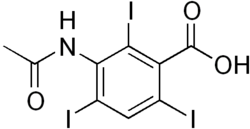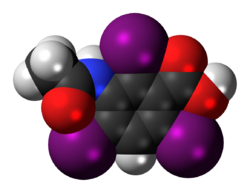Chemistry:Acetrizoic acid
 | |
 | |
| Clinical data | |
|---|---|
| Trade names | Urokon, Triurol, Salpix, others |
| AHFS/Drugs.com | International Drug Names |
| ATC code | |
| Identifiers | |
| |
| CAS Number | |
| PubChem CID | |
| DrugBank | |
| ChemSpider | |
| UNII |
|
| KEGG | |
| ChEMBL |
|
| Chemical and physical data | |
| Formula | C9H6I3NO3 |
| Molar mass | 556.864 g·mol−1 |
| 3D model (JSmol) | |
| |
| |
| | |
Acetrizoic acid is a pharmaceutical drug that was used as an iodinated contrast medium for X-ray imaging.[1][2] It was applied in form of its salt, sodium acetrizoate, but is no longer in clinical use.[3]
Chemistry and mechanism of action
The substance has high osmolality and is water-soluble. The three iodine atoms in the molecule readily absorb X-rays and are therefore responsible for its usability as a contrast medium.[3]
History
Acetrizoate was developed by V.H. Wallingford of Mallinckrodt, and introduced in 1950;[4] it was employed as a contrast agent for several radiographic studies, including pyelography,[5][6] angiography of the brain, carotid arteries and the aorta,[7][8] and cholecystography.[9][10] It was soon found to be highly toxic to the kidneys and nervous system—work urging caution in its administration was published as early as 1959,[11] after reports of adverse reactions ranging from hypersensitivity to brain damage—and was eventually replaced by other agents with higher efficacy and lower toxicity, such as sodium diatrizoate, a closely related compound.[4]
Trade names
Trade names include Urokon, Triurol and Salpix, as well as Gastrografina and Urografina in Portugal.
References
- ↑ International Drug Names: Acetrizoic acid.
- ↑ Cheng, K. T. (2004). 5-3-Hydroxy-2-hydroxymethyl-propionamido)-N,N´-dimethyl-N,N´-bis-(2,3-dihydroxypropyl)-2,4,6-triiodoisophthalamide. PMID 20641966.
- ↑ 3.0 3.1 "Acetrizoate sodium". Online Medical Dictionary. University of Newcastle upon Tyne. March 5, 2000. http://cancerweb.ncl.ac.uk/cgi-bin/omd?acetrizoate+sodium.
- ↑ 4.0 4.1 McClennan BL (1990). "Preston M. Hickey memorial lecture. Ionic and nonionic iodinated contrast media: evolution and strategies for use". AJR. American Journal of Roentgenology 155 (2): 225–33. doi:10.2214/ajr.155.2.2115244. PMID 2115244.
- ↑ "Preliminary report on urokon, a new excretory pyelographic medium". J Urol 63 (6): 1109–12. 1950. doi:10.1016/s0022-5347(17)68871-2. PMID 15422724.
- ↑ "A comparative clinical trial of urographic media: renografin, hypaque, and urokon". Radiology 66 (6): 871–3. 1956. doi:10.1148/66.6.871. PMID 13323329.
- ↑ "Report of one hundred carotid angiograms taken with the new contrast medium acetrizoate (urokon) on Chamberlain's biplane stereoscopic angiographic unit". AMA Archives of Neurology & Psychiatry 69 (5): 651–2. 1953. PMID 13039633.
- ↑ "Cerebral arteriography with sodium acetrizoate (urokon sodium) 30%". AMA Archives of Surgery 67 (5): 741–5. 1953. doi:10.1001/archsurg.1953.01260040752012. PMID 13103941.
- ↑ ORLOFF TL (1955). "Intravenous cholecystography with a new medium; experience with sodium acetrizoate (urokon sodium) seventy per cent". AMA Archives of Surgery 71 (4): 620–2. doi:10.1001/archsurg.1955.01270160146019. PMID 13258064.
- ↑ "Gallbladder visualization following the use of 70 per cent sodium acetrizoate (urokon sodium) for intravenous pyelography". Radiology 69 (4): 576–7. 1957. doi:10.1148/69.4.576. PMID 13485425.
- ↑ "A plea for caution in the use of sodium acetrizoate (urokon) for aortography". Ann Surg 150 (1): 172. 1959. doi:10.1097/00000658-195907000-00022. PMID 13661846.
 |

